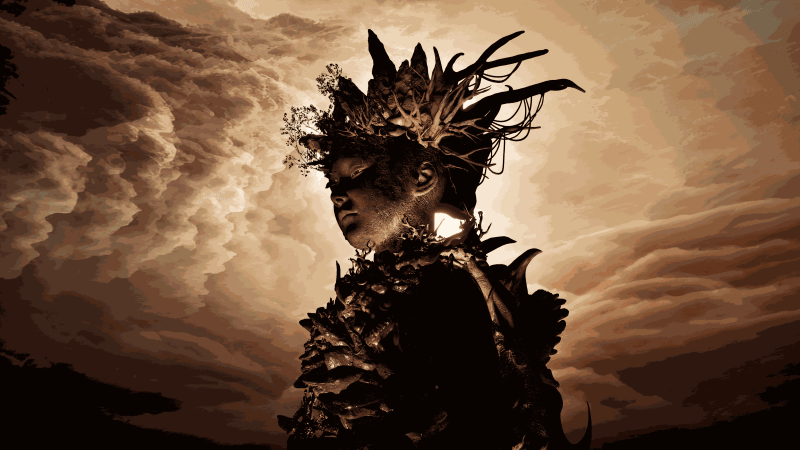Eunjo Lee’s solo exhibition ‘When Forgiving the Sunlight’ features a major new digital work and accompanying wall-based works. It continues the artist’s exploration of the interconnectedness of human and non-human entities and the landscapes around them, considering all elements as part of a greater whole. Within that, ‘When Forgiving the Sunlight’ considers the interweaving of life and death as well as the possibility of life in what we normally consider inert. Lee revisits concepts such as archetypes, the role of myth and the possibility of a shared consciousness, themes which have been articulated by thinkers such as Carl Jung and Joseph Campbell.
‘When Forgiving the Sunlight’ develops ideas seen in Lee’s “The Lullaby of the Ruins” that was awarded the Mansfield-Ruddock Prize for MA graduates at Ruskin School of Art in 2024. In both works Lee uses gaming-graphics software such as Unreal Engine and Blender to create spectacular, immersive worlds. She employs deliberately slow tempos and tension-filled scores to create narratives rich in symbolism that are evocative and layered. Non-living matter in the form of ruins and stones are at the heart of these narratives, with the protagonist depicted moving slowly around them, as if always considering the essence of their natures.
The setting of ruins is suggestive of lives and civilisations that have disappeared but remain present through their traces. In the earlier work, the protagonist sings lullabies to these ruins, perhaps intuitively sensing that they once had a life and might do so again. At any rate, there is something in them which resonates with them; Lee’s works suggests that the protagonist, and by extension, the viewer, has an intuitive link with the ruins and understands their potential for life. When Haleah, the protagonist of ‘When Forgiving the Sunlight’, declares that a stone is dead, perhaps we might understand it as conveying that the stone once had and potentially has again, life. Haleah later sacrifices herself to a monstrous stone entity in order to offer it the chance to return to life. Ruins then, become a site of lives and civilisations that might have disappeared but have the potential to return.
Whilst the rocks and stones in Lee’s films might have the potential for life, it is important that they remain inert through the works and so resist an easy anthropomorphism. Instead, Lee invites us to consider a different way of viewing the objects that surround us that cannot represent themselves, and by extension perhaps also think of those subjects who are not allowed to fully represent themselves. Hospitality becomes a key theme; what does it mean to allow the other a proper space to fully represent themselves? Moreover, by referencing the visual language of immersive open-world gaming, Lee foregrounds a sense of discovery of the other through the various quests that structure those games, whether human or monstrous, friend or foe, and by extension, self or other. In a number of the most well-known open-world games such as ‘Red Dead Redemption 2’, at the end the story hinges on self-discovery through the many varied encounters that the gamer as protagonist has had.
As well as open-world gaming and thinkers such as Jung, Lee’s work nods at writers such as Bruno Latour, Jane Bennett and Thomas Berry. All of these writers share a move away from the anthropocentric dualism of western traditions towards thinking about the relationship between humans and non-humans as being filled with meaning and potential continuities, interactive and horizontally structured in the sense of being equals rather than hierarchical. Lee locates the practical possibility to enacting this shift as being within the digital realm. For her, emergent digital technologies and AI are seen as less of an existential threat and more of having the potential to extend a shared human consciousness. This productive use of AI suggests it can become the “internet of living things” so that advanced technology (somewhat paradoxically perhaps) offers the opportunity to recover the expanded consciousness of earlier societies.
‘When Forgiving the Sunlight’ is Lee’s first solo exhibition since graduating with an MFA from the Ruskin School of Art. Prior to that Lee completed her BA in Fine Art and History of Art at Goldsmiths where she was awarded the Warden’s Prize in 2023. She will have her first institutional exhibition at Goldsmiths CCA in March 2025.
For any pdf requests, image or press release information please email georgia@niruratnam.com.

